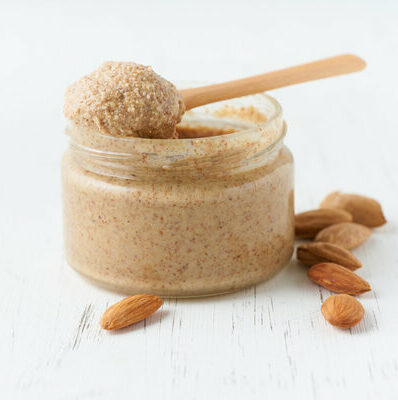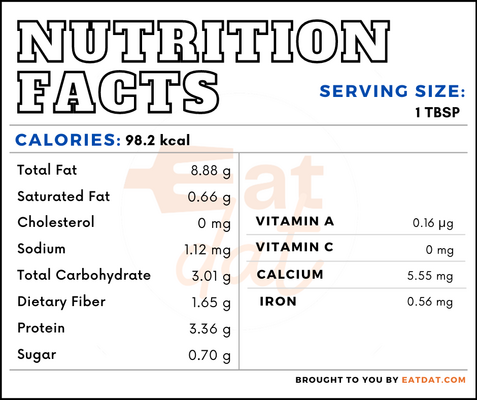
Almond Butter
What is Almond Butter?
Almond butter is a nut butter made by grinding almonds into a creamy paste. This dark brown paste has a rich, nutty flavor and tastes strongly of almonds. Almond butter comes in crunchy and smooth varieties and works as a decent, albeit expensive, alternative to peanut butter.
- Still, it is a popular choice for those with peanut allergies.
- This nut butter is commonly used as a spread and is extensively used in salads, baking, and cooking.
Some of the most popular almond butter brands on the market include:
- Once Again
- Barney
- MaraNatha
- Artisana Organics
- Woodstock
- Justin’s
- Wild Friends
Origin of almond butter
Almonds date back to at least 1400 BC, when they were referenced in The Bible’s Book of Numbers. This nut would continue to be a symbol of spring and fertility in many cultures. Nonetheless, the exact origin of almond butter is unknown. However, it may have been invented by John Harvey Kellogg. Kellogg’s almond butter was mentioned in the Journal of the American Medical Association in 1913.
Nutrition
Nutritional profile for almond butter (1 tbsp):

Almond butter is rich in calcium, magnesium, phosphorus, potassium, and beta sitosterol. Additionally, it contains folate, choline, vitamin E, and essential fatty acids in decent amounts.
Almonds have a low glycemic index, making them perfect for diabetics. They are associated with cardiovascular health and other obesity-related diseases because of their tendency to reduce LDL cholesterol. Almonds have antioxidant and anti-inflammatory properties due to the polyphenolic compounds in them, such as flavonoids and proanthocyanidins. These compounds are mainly located in the skin of these nuts. However, processing of almonds may lead to some loss of nutrients. Also, roasting leads to distortion of the protein and damage of cell walls.
Commercial production
First, the almonds are harvested by a machine called a tree shaker, sun-dried, and graded, after which they undergo laser screening to sort out damaged nuts. Then, they are roasted to bring out the flavors. After that, they are milled between two stones to squeeze out the liquid, creating a smooth paste. Finally, salt is added to the mixture, and the almond butter is ready to be bottled.
The USA is the top almond-producing country in the world, followed by Spain, Iran, Morocco, Syria, Italy, Australia, Algeria, and Turkey. Also, the USA is the top almond consumer, followed by India, Germany, and Spain.
Almond butter recipes
This butter is a rich and nutty paste which may be used in baking and cooking to enhance flavor. Additionally, almond butter is a popular topping for toast, pancakes, and waffles. Here are some recipes to try:
- Chocolate Chip Cookies
- Energy Balls
- Vanilla Espresso
- Chocolate Almond Bars
- French Toast
- Lemon Cake
- Strawberry Parfait
- Pie with Chocolate Saltine Toffee Crust
- Garlic Almond Noodles
- Almond Butter Pesto Pasta
- Sweet Almond Rice Pudding
- Rice Crispy Bars
- Stir Fry
- Almond Butter Latte
FDA regulations
The USDA defines almond butter as butter prepared by grinding shelled, blanched or unblanched, raw or roasted almonds to which may be added ingredients such as salt, honey, evaporated cane syrup, corn maltodextrin, flax seed, wheat germ, cocoa powder, cocoa butter, vanilla, etc. The product must contain at least 90 percent almonds and may contain other stabilizing agents. The FDA has previously recalled products due to their failure to declare the food product may contain peanut butter, so as to protect individuals with peanut allergies.
References
Barreca, Davide et al. “Almonds (Prunus Dulcis Mill. D. A. Webb): A Source of Nutrients and Health-Promoting Compounds.” Nutrients vol. 12,3 672. 1 Mar. 2020, doi:10.3390/nu12030672, https://www.ncbi.nlm.nih.gov/pmc/articles/PMC7146189/
Liu, Yanan et al. “The effects of daily intake timing of almond on the body composition and blood lipid profile of healthy adults.” Nutrition research and practice vol. 11,6 (2017): 479-486. doi:10.4162/nrp.2017.11.6.479, https://www.ncbi.nlm.nih.gov/pmc/articles/PMC5712498/
